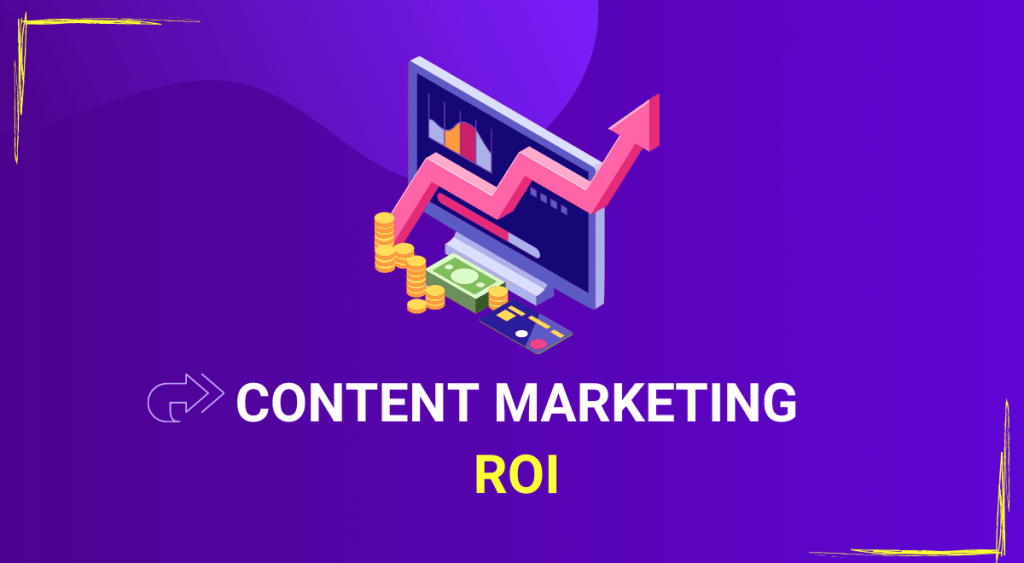Only 21% of B2B marketers are successful at measuring and tracking their content marketing ROI, according to a study of ContentMarketingInstitute.
Yes, only 21%.
Is it so hard to measure the effectiveness of your content marketing program?
I won’t say that it is very hard but not simple either.
In this article, you’ll learn a step-by-step process to measure, track, and even improve your content marketing effort.
But before we dive deep into the process, it is crucial (Must) to know what are not effective ways of content measuring.
Here are the following.
- Measuring the website traffic as an only KPI is not content marketing evaluation (I will explain why).
- Calculating the effectiveness without aligning it with your content marketing goal is not the correct way of measuring.
Download FREE ROI Calculating Template to monthly track your content marketing effort
Relevant article for you: 7 key findings from analyzing 5514 content marketing jobs
What Is Content Measuring/ROI?
ROI in content marketing is about how much you’re making as compared to how much you’ve invested.
The moment you earn more than you invest, your ROI value will be positive.
Here’s how to calculate ROI.

Here’s a detailed guide on content marketing.
Now, you get to know what ROI is and How to calculate this.
But let me give you an example, where you might get confused with this above ROI formula.
Let’s assume that your content marketing goal is brand awareness. In this case, you’re not thinking about how much revenue to generate but thinking about how much people are talking about my brand.
So, how will you calculate the ROI when you’re not going to earn a single buck?
This is where most people think that the ROI formula does not apply to my campaign.
But the fact is, you can still calculate the ROI and check whether your ROI is positive or negative.
Here’s how you can do this.
Let’s assume again, during the first nine months of your content marketing program, you were able to get 3000 Facebook page likes and 7000 website traffic(Not adding other metrics to make it simple).
Next, you can calculate how much you had to invest in acquiring these numbers.
For example, let’s say you can estimate how much you had to pay to get 7000 website traffic from Google.
You can use Google Adwords to see how much people are paying to show advertisements on keywords that you’re already ranking for.
That way, you’ll have an approximate value of what could be the cost of acquiring this number of site traffic.
Similarly, you can also head over to Facebook and see how much it cost to get 3000-page likes.
First go to your Facebook Ads manager. Then select the goal of promoting your page.
That will show you an approximate value of acquiring a specific numbers of page likes.

Now, set up your audience in the setting and adjust the budget to see the cost of your page likes if you had to acquire the same numbers through paid promotion.

The idea is to convert your statistics into monetary value.
The process is like converting some amount of gold into its monetary value.
Obviously, calculating the worth of social shares, engagement is hard, but you can have an approximate value of your numbers.
But once you complete reading this article, you’ll be able to measure the effectiveness and ROI of your content effort.
That brings me to the next point. That is why it is necessary to measure the effectiveness of content marketing performance.
In this part, you’ll also learn some common mistakes that make it difficult to calculate the ROI.
Let’s understand this.
Mistakes to avoid while calculating the ROI

Most of the reasons why marketers aren’t able to measure and track the performance are listed here.
Here are these mistakes.
- Working on too many KPIs
- Not aligning your content marketing goal
- Wrong expectations
Let’s understand one by one.
1. Working on too many KPIs
Key-performance-indicators are used to measure the performance, and when it comes to content marketing, there are so many KPIs.
Even we can divide KPIs based on marketing goals as well.
Here’s a list of KPIs based on category.

All of these metrics are used to see how close we are at our targeted marketing goals
For example, to measure the effectiveness of a content marketing campaign, targeted for brand awareness, we can look at the numbers like website traffic, unique visitors, social shares, and many more.
That means the other metrics or KPIs that don’t have a direct relation with brand awareness are less important.
But what many marketers do is they try to play with KPIs that don’t even have a direct impact on your goal.
Here’s an example.
Let’s say your goal is to generate leads for your business. So whenever you’re going to measure the effectiveness of your effort, you have to prioritize the following KPIs as they are related to your ultimate goal, which is lead generation.
Lead conversion rate
Number of downloads
Blog subscriptions rate
Landing page performance, etc.
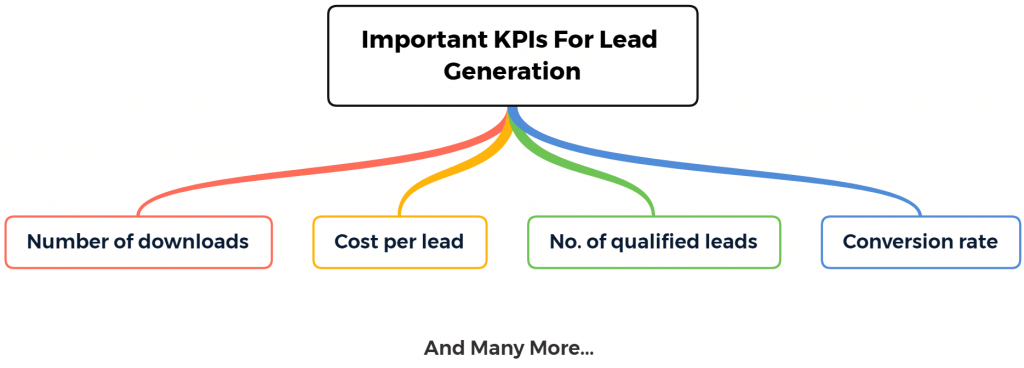
These metrics are obviously at the high priority, but when you try to mix these metrics with some others such as social shares, page likes, video views, you’ll get an unclear image.
It doesn’t only make your estimation difficult, but it also gives you unclear results.
[Actionable tips: While measuring the success of your content, try to be specific in terms of metrics or KPIs. Don’t look for every metric available to you.]
2. Not aligning your content marketing goal
Again, there will be some metrics that you don’t need to bother about. You might get thousands of unique visitors/ month.
These are called ‘looking good metrics.’ It may look nice to get tons of website traffic, but this hardly adds some additional value to your business if it fails to match your goal.
This is why setting your marketing goal is so necessary.
And, aligning your marketing goal with tracking your performance will help you in moving in the right direction.
Even if you fail to match your targeted goal, you’ll still know where you need to work more and what to eliminate from your plan.
[Actionable tips: Understand your marketing goal and based on this focus on the KPIs that have a direct relation with your goal]
3. Wrong expectations
Let me ask you a question.
If you see a negative ROI in your content marketing campaign, then will you stop you from working on this?
Let’s clear this even more.
You noticed that after six months of your content effort, there is a negative ROI, which means you’re investing much more, and in return, you’re hardly getting any significant results.
So what will you do at this point?
Will you give up?
If your answer is Yes, then keep reading to know why it is wrong.

If you’re just starting in content marketing, then it’s a must to know about what to expect.
The above graph is showing the followings:
1. Up to a certain period of time (A-B), your ROI will be on the negative side- Because Content Marketing takes time to reflect results.
This period of time, when the ROI will be on the negative side, actually depends on the content platform and what niche you’re in.
2. In the long term (B-C), ROI is going to get bigger and bigger.
3. All you need to do is overcome the negative period (A-B)of time when you’re not going to get enough results.
4. Don’t make major changes in the Content Marketing Strategy when you’re in this zone.
The best practice is to wait. At least 6–12 months to get results in Content Marketing.
Hence whenever you’re going to measure the effectiveness of your content marketing program, consider this fact, especially if you’re at the beginning level.
Now, let’s move forward to see how to calculate the Return and investment separately.
Calculating return and Investment
Download the FREE ROI calculating template to track your monthly progress.
Calculating investment in content marketing
First, we’ll see how to calculate the investment in terms of content creation, distribution, software/tools, and more.
To organize things, we’ll divide the total investment into four different categories.
Here are these groups.
- Cost in planning and strategizing
- Creation cost
- Distribution cost (optional)
- Software and tools
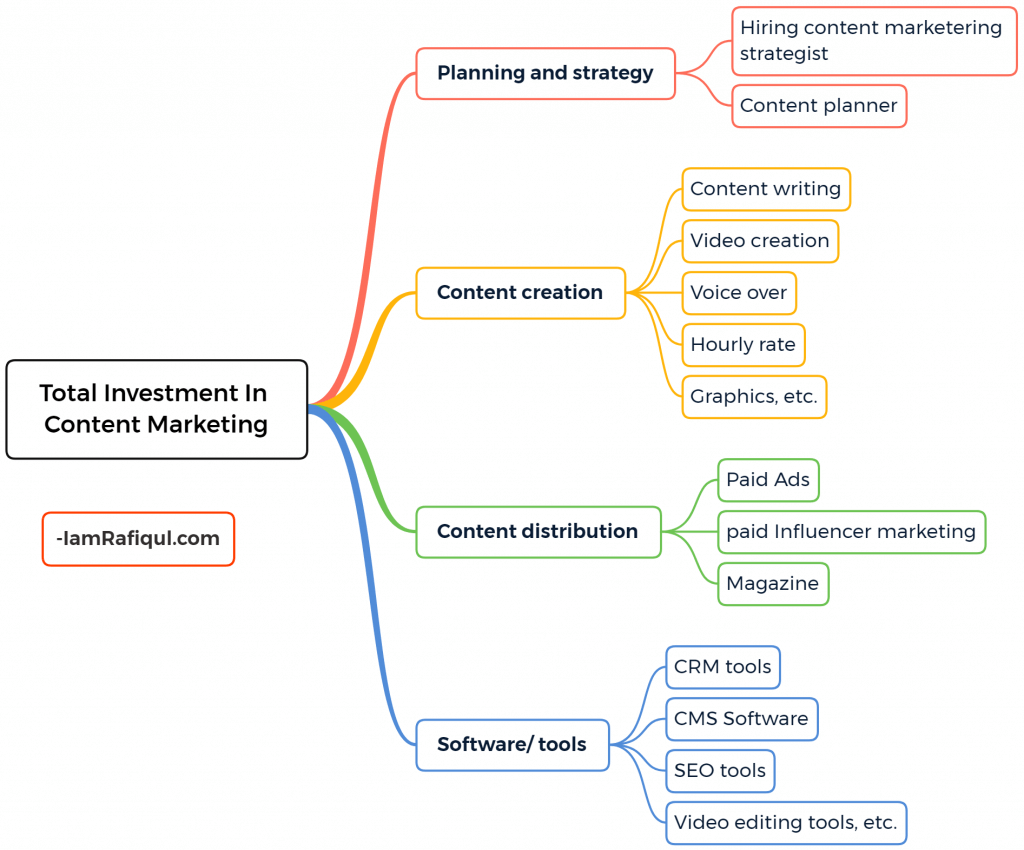
The idea of having these groups is that you’ll not forget any of the costs into your account. That will also help you in getting a more clear ROI calculation.
Cost in planning and strategizing
This category will include all the costs that you’ve invested in creating and planning the marketing plan.
In this category, the cost is related to getting a content marketing strategy. Many reliable services make a complete content marketing plan for you.
Even if you’re an experienced guy in this field, then it is always better to get someone to proof check your overall plan.
Along with a marketing plan, you could also hire any freelancer to prepare a content strategy so that you never get out of ideas.
All you need to do is note down the cost of getting your content marketing strategy ready.
Learn More About Content Marketing strategy (Topic cluster and pillar page)
Cost of creating and managing content
This is where the real fun begins. Creating content is where you’ll invest your most of your time and money as well.
So you have to calculate the worth of your time along with the money you have spent.
The cost of creating and managing content may include the following.
Hiring a blogger, video editor, designer, and more.
Again, managing content means you may have hired someone to post consistently all over the social media platforms. The person is also responsible for scheduling your content on various platforms such as YouTube, Blogs, etc.
But what about if you’re doing most of the content marketing work by yourself?
Well, in that case, you need to calculate the amount of time you’re dedicating to manage all of the work.
For example, if you’re working 2 hours/day and six days/week, then each month you’re investing 52 hours/month.
Once you calculate the total amount of time you’re putting in the work, you need to set an hourly rate.
Even if you don’t have the budget to hire any paid services, it is still vital.
Set an hourly rate, say $20/hour.
Based on this rate, the worth of your monthly time investment is around $104.
In this similar manner, you need to calculate the cost of software and tools.
Cost of software/tools
Software and tools cost may include the following.
- Domain and hosting cost
- Podcast mic
- Video editing software
- SEO tools
- Email marketing software, and many more.
All you need to do in this section include the cost of all the software and tools that you’ve used in the campaign.
By covering all of these four groups, you’ll be able to calculate the total investment of your content marketing effort.
So, the first part of calculating the ROI is almost done.
Next, you need to calculate how much return you’re getting every month.
Calculating Return in Content Marketing
This is the most tricky part of your ROI calculation because, in most cases, you’re not going to get revenue in return.
You can measure the sales, but how will you measure the worth of leads in terms of monetary value?
In this case, you need to convert the numbers.
Since calculation will vary based on your metrics and marketing goal, I will share the ways to calculate or turn the parameters into monetary value.
I will share some of the ways of converting the metrics into the monetary value.
Not in every case, you can do this, but in the majority of the time, you can calculate the worth that you’re getting in return.
1. Value of leads
Let’s assume you have generated 1000 leads from your blog and social media account.
Now, we’ll find out the average lead value so that you can estimate your total return.
You’re generating leads to sell a product. Let’s say the worth of the product is $1000. Now, with the help of analytics tools like google analytics, or any other tool, you can see the conversion rate.
Again, if you have 1000 leads and the conversion rate is 2 %, then this means that out of 1000 people, twenty people bought your product.
Since the selling cost of each product was $1000, the average value of each lead = (average selling cost * conversion rate) = ($1000 * 0.02) = $20
[As, 2% = 0.02]

That way you can calculate the value of your email list as well.
Just multiply the conversion rate with the average product or service value.
2. Value of your site traffic
In most cases, people just calculate the value of leads or sales generated through the content marketing effort.
But there’s more that you must consider into the account, and that is the value of your website traffic.
Here’s an example.
Consider that your site is getting 1000 monthly traffic organically. But what if you had to get that same amount of traffic via PPC?
Obviously, you had to pay for this to generate that much traffic to your site.
And, this is the equivalent cost of your site traffic.
By using tools like Ahrefs, Semrush, you can get an equivalent value of your website traffic.
Here’s the definition of traffic value from the Ahrefs official.
Though the value might be absolutely accurate, it is still better to get a rough idea than not considering the traffic value at all.
Well, other metrics cannot be measured in dollars, but these metrics are crucial for measuring the success of the project.
At the last stage, calculate the total amount of investment and return. And, by using the above ROI formula you’ll see your ROI of content marketing.
Metrics to measure the effectiveness of content marketing
Returning visitors and New visitors
Most of us only track the monthly search traffic of our site. But there’s more to learn about the audience.
New visitors are the people that visited your site for the first time. You can also call this unique visitor.
This data will tell you the reach of your content from the site.
So by knowing the value, you may have an idea about how well your site is performing every single month.
Likewise, the returning visitors are the people who are visiting your site multiple times. The number tells you about how much people are liking your content.
The more returning visitors you get, the more people like your content.
Just simply head over to Google analytics And click on the Audience section. Under the Audience section, you’ll see a tab called New vs Returning.

Keep tracking these numbers to get the idea of the reach of your content and how much people like the content of your site.
The next metric is the Funnel conversion.
Funnel conversion
Some pages like pricing, services, checkout can be considered as a part of the funnel.
For example, if you get to know the % of site visitors who are reaching the service page of your site, then you’ll see the number of qualified leads.
Qualified leads are those that are interested in doing business with you.
These are the people who will visit the pages like price, service, contact, checkout etc.
So to understand the number of qualified leads, you’ll need to set up goals in Google Analytics.
Once you complete the setup, you’ll know which pages are converting well and what are the pages that have a shallow conversion.
So by knowing what’s not working, you can further investigate what’s wrong in the process and eventually increase the conversion rate.
So Let’s see how to set up goals in Google Analytics.
In this tutorial, I will show you how to set up a custom goal to see the conversion rate for visiting a specific page.
Step 1. Log in and Go to your Google Analytics account
Step 2. Head over to Admin panel
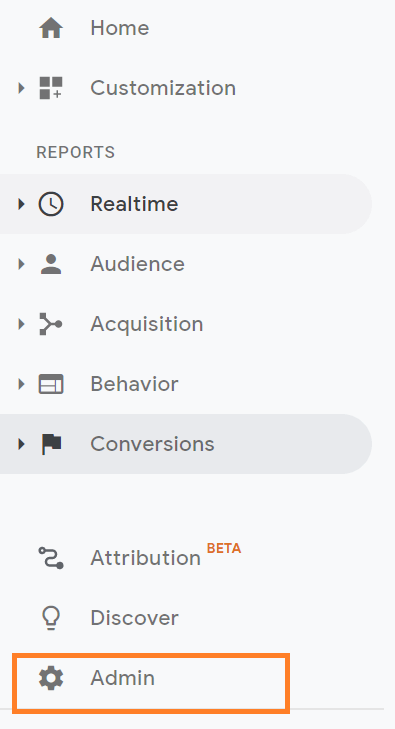
Once you select the Admin tab, you’ll see three different sections, such as Account, property, and view.
Under the view panel, you’ll see the Goal section.
Click on the Goal.
Step 3. Setting up your goal
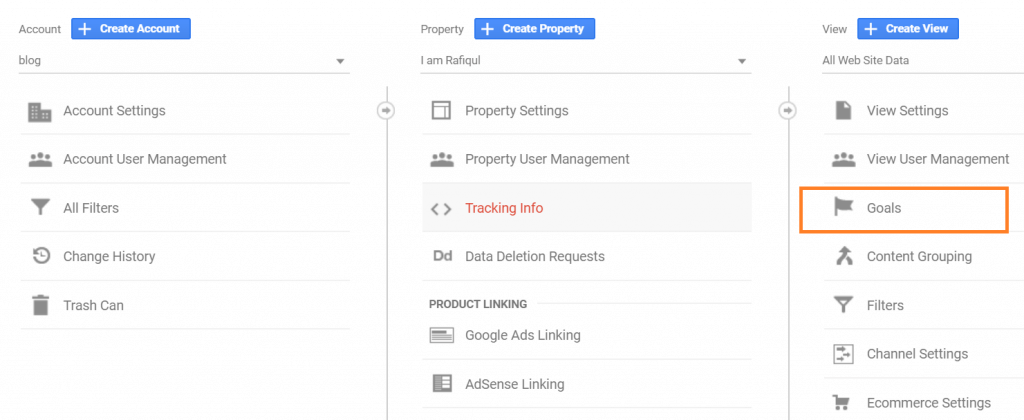
Click on the Click goal.
Next, you need to select the goal, and you’ll get many default goals to make your job easier.
But, to make a funnel visualization, you need to click on the custom goal.
Just scroll down a little, and you’ll see a custom setting. Just click on it.
Step 4. Setting up the custom goal
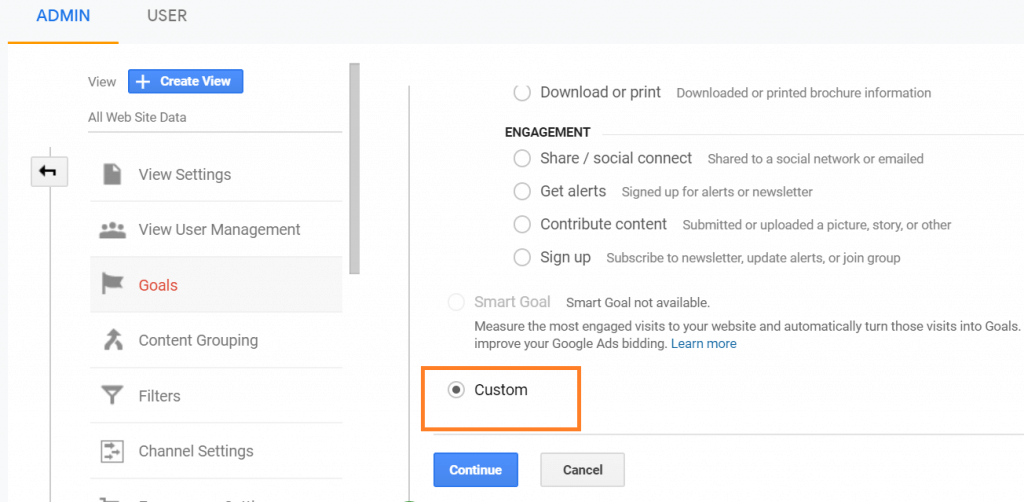
First, name the goal so that you can organize all of the goals. In the Types setting, select destination.

Then click on continue.
Once you click on the continue button, you’ll need to set up the destination to set the goal.
In the destination section, just enter the URL’s unique part that you want to set as a final goal.
Whenever a person reaches that page, it will be counted as a successful goal conversion.
In this case, I want to set the ‘content-marketing-services’ page as the ultimate goal to track how many people are visiting that specific page.
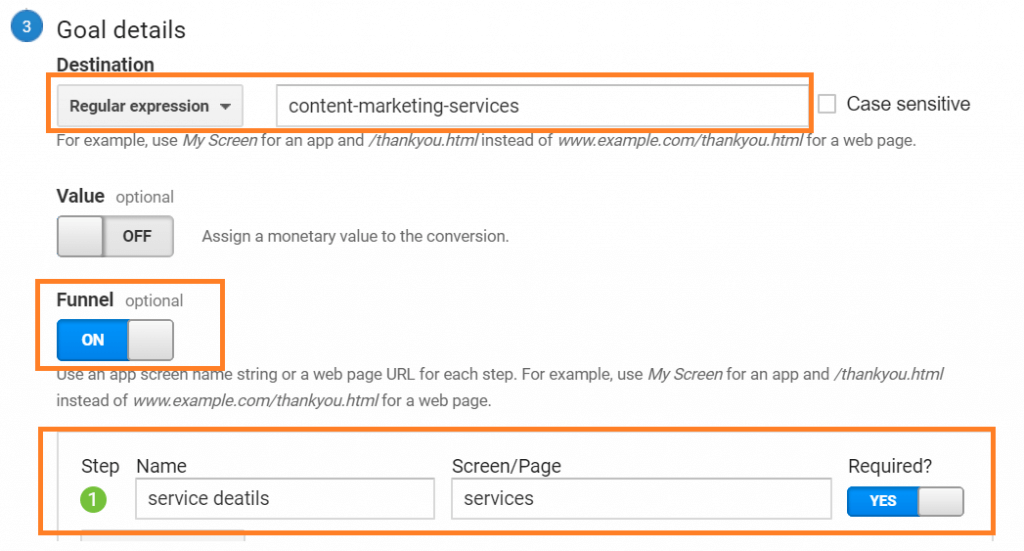
You can also add a monetary value for each of your goal accomplishments. Though the value setup is optional, I would recommend you to enable the funnel tab.
Enabling the funnel tab will help you visualize how many people are converting from each of the stages.
Now set up the steps that need to be accomplished before completing the final goal.
Similarly, enter the unique URL part of the page that you want to set as a step.
Here is what I did.
I have set the service page of my website as a step. A successful conversion will happen only when a person first completes the steps (first, visit the service page) before reaching the destination URL (The ‘content marketing services’ page).
In my case, when a person first visits the service page and then goes to the pricing page, it will be counted as a successful conversion.
Next, enable the required tab and click on ‘verify’ to save.
Your setup is done.
Want to see how cool and effective the funnel visualization works?
Here it is.
Follow the path to see the funnel visualization for the goals you have just setup.
Conversion 🡪 Goals 🡪 Funnel Visualization

Learn everything about Funnel visualization in Google analytics.
This is how you’ll be able to set up a goal in google analytics.
By default, Google analytics has many templates for setting up your goal. Goals like sign up for an event, account creation, number of downloads, and more are available in the analytics.
You need to select your goal that may help you in the future to optimize your content marketing effort.
Remember that you can only set up to 20 goals, so it is always better to set goals for only essential metrics.
Final words
Download your FREE ROI Calculating template to track your monthly progress in content marketing.
ROI is a critical indicator that tells about your current performance and also indicates you where you’re lacking.
If you’re just a beginner, then start with just calculating your investment cost and then compare that value to the cost of return.
This article has also shown you how to convert the content marketing metrics into a monetary value.
Only when you’re at an intermediate level, then keep playing with Google analytics.
There is no better tool than Google Analytics to tell you what’s going well and what’s not in your content marketing effort.
And last advice from my experience is never to expect a positive content marketing ROI at the beginning. Accept that up to a certain period of time; you will stay in that negative zone shown in the above illustration.
Content marketing is like an asset. The more time and effort you give, the more ROI it will produce in the future.

Sk Rafiqul Islam is a content marketing practitioner with 3+ years of practical experience. He spends most of his time helping businesses to build a loyal audience with content marketing. He is also running a tech career blog called 10Pie and content marketing VIP, a bi-weekly marketing newsletter. In his free time, he loves reading books and playing football.
